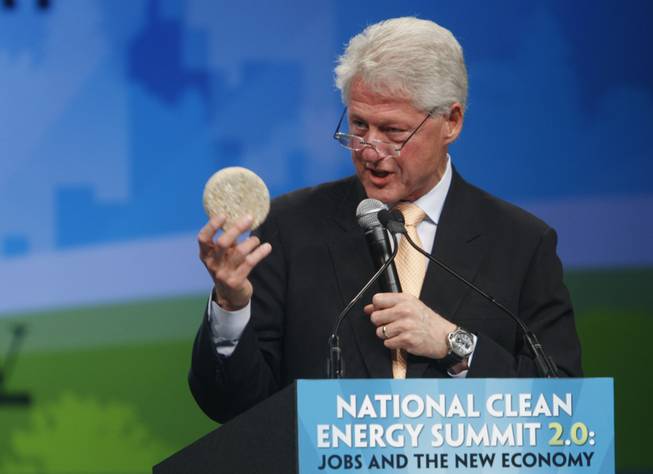
Former President Bill Clinton holds up a tablet of cooking fuel made in Haiti from recycled material at National Clean Energy Summit 2.0 on Monday.
Tuesday, Aug. 11, 2009 | 2 a.m.
In Today's Sun
Clinton visits UNLV
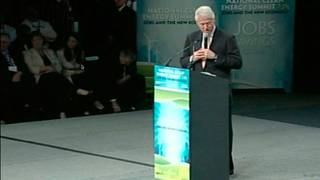
Viewing video requires the latest version of Adobe's Flash Player
Sun Archives
Sun Coverage
Beyond the Sun
At the National Clean Energy Summit on Monday afternoon, former Vice President Al Gore made a promise to the people of Las Vegas.
If the Senate passes an energy bill to promote renewable energy and energy efficiency, Gore will return less than two weeks later to train a group of people in how to conduct his famously wonky but demonstrably effective slide show presentations that vividly depict the perils of global warming.
It was those slide shows that over the past few years have helped raise awareness about scientific consensus that carbon emissions cause climate change, and have earned Gore an Emmy, an Academy Award and a Nobel Peace Prize.
Gore’s offer was in keeping with the theme of the second annual conference, pulled together by Senate Majority Leader Harry Reid and uniting more than a dozen high ranking business and governmental leaders at UNLV’s Cox Pavilion. Seated for the morning session around a hexagonal table that evoked an oversized board meeting, participants were ostensibly exchanging ideas about how to grow the economy around clean energy and highlighting Nevada’s role in that.
But this year, the summit more than anything else promoted a single idea: Make sure that the public support is vast enough to allow 60 senators to vote for an energy bill that includes higher costs for carbon emissions and a national requirement to acquire a certain percentage of energy from renewable sources.
“If we want a good bill we have to convince people that this is an economic winner,” said former President Bill Clinton, who spoke for nearly an hour Monday afternoon. “We’ve got to convince people that this is good economics.”
Reid described energy legislation as the second of two bills that will define the success of this Congress.
The other, health care legislation, has recently run into angry Republican opposition, including an army of activists that is disrupting appearances by Democratic representatives across the country during the congressional recess.
While most of the country focuses on the health care debate, participants in the energy summit used the opportunity to kick off their own campaign in favor of energy legislation.
“Everyone here can make a difference in that,” Gore said. “Special interests have powerful voices, but the people have the most powerful voices.”
Gore said the “economic crisis,” “security crisis” and “climate crisis” are tied together.
“The common thread running through them is our absurd and dangerous over-dependence on carbon-based fuels,” Gore said.
The House in June passed a climate bill sponsored by Reps. Henry Waxman of California and Edward Markey of Massachusetts that would require a 17 percent reduction in greenhouse gas emissions by 2020 and an 83 percent reduction by midcentury. The bill would do that by creating a cap on carbon emissions and allowing businesses to trade emission credits.
The bill also would require utilities to get 20 percent of their energy from renewable sources by 2020 and includes efficiency standards for buildings. It also would add billions of dollars for clean energy projects, including a so-called “green bank” to funnel private capital into energy efficiency and renewable energy projects, on top of billions for clean energy approved in the economic recovery bill last winter.
Supporters say the energy bill would make the country a leader in technologically advanced clean energy by making private investments in renewable energy and energy efficiency more secure, leading to job creation.
“We have to have a second industrial revolution,” said Energy Secretary Steven Chu. “We need to develop technology that enables us to get the energy we need to develop and prosper but will reduce and eliminate carbon dioxide. Once we get this machine geared, we’d be invincible.”
But opponents call it a hefty new tax and vow to strongly oppose its passage in the Senate.
Reid is expected to introduce a revamped version of the bill in the Senate after the recess.
Sure to be in that version, Reid said, is more support to build transmission lines to connect far-flung renewable energy resources to urban centers. That issue was also highlighted at last year’s conference and at a session this winter in Washington, D.C.
“I will not be satisfied with an energy bill unless it has a strong component that allows transmission,” Reid said.
He said more than 7,000 miles of natural gas pipeline have been constructed in the past 10 years compared with just 600 miles of power lines, and harked back to when railroad lines were built to crisscross the country.
The country has to confront the logistical challenge of renewable energy the same way it solved other problems, Reid said.
Noting that railroad construction was facilitated by the power of condemnation and eminent domain, Reid said: “We have 120 some-odd agencies that have a stranglehold on our ability to move electricity. They are antiquated. They stop power from being transmitted.”
But rather than solely focus on vast new infrastructure, Clinton implored participants to consider how big change can be made through more mundane efforts such as improving energy efficiency, building by building.
“I think it is worth remembering that the least sexy topic is where the most jobs are,” Clinton said in a keynote address after lunch.
Clinton said most energy plans are “just piddling” compared with the 7 million jobs the country has lost in the recession.
“We’re still just playing with this,” Clinton said. “We have to figure out how to do this on a national scale.”
Along with others, Clinton promoted energy efficiency as a way to create jobs and reduce carbon emissions.
Buildings account for 70 percent of U.S. electricity consumption and 40 percent of total U. S. greenhouse gas emissions, according to a study released Monday by the Center for American Progress, a liberal think tank closely tied to the Obama administration and one of the summit’s organizers.
The organization recommended retrofitting 50 million buildings — or 40 percent of the building stock — by 2020 with $500 billion in public and private investment.
That would create 625,000 full-time jobs and save $32 billion to $64 billion a year in energy costs, the organization says.
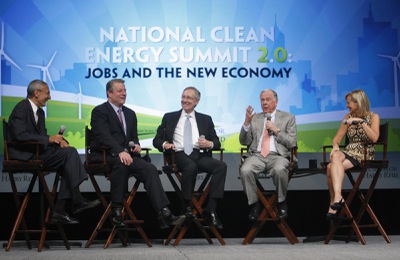
Energy executive T. Boone Pickens (second from right) responds to a question during a town hall portion of the National Clean Energy Summit 2.0 at UNLV Monday. Other participants are (from left) moderator John D. Podesta, former Vice President Al Gore, Senate Majority Leader Harry Reid and Assistant Secretary of Energy Cathy Zoi.
Clinton recommended using public-private partnerships to secure bank loans to pay for the outfitting necessary for buildings to be more energy efficient.
“You’ve got to get the banks involved in this if you want to quit piddling around,” Clinton said. “This is boring. It’s not nearly as interesting as the newest solar technology.”
Another “simpler” solution promoted by many summit participants this year is natural gas, which emits 50 percent less greenhouse gas than coal.
In the last year, vast new supplies of natural gas were discovered in shale, which has brought the price of natural gas down 70 percent.
Center for American Progress CEO John Podesta called natural gas a “game changer” and “the bridge fuel to the 21st century.”
Reid recently introduced legislation with incentives for vehicles that run on natural gas.
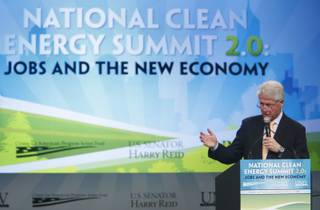
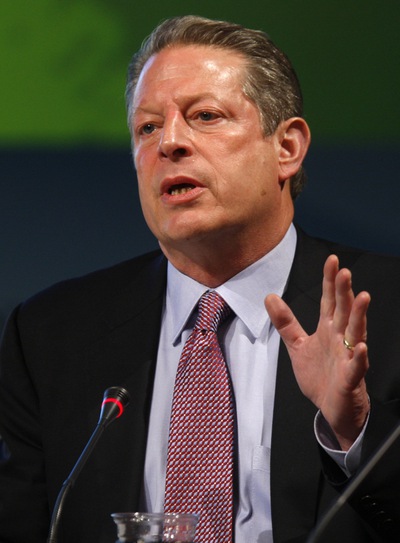
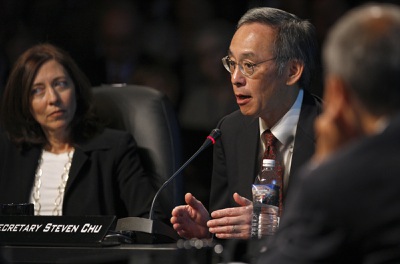
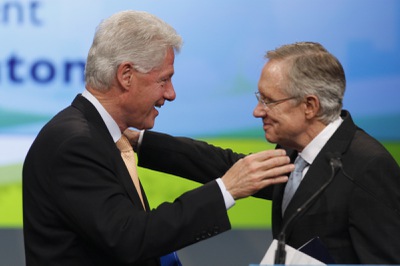
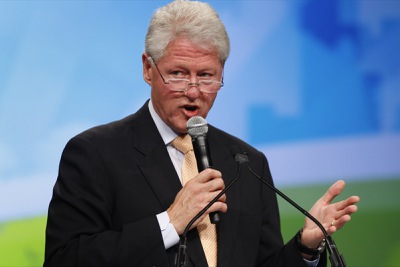

Join the Discussion:
Check this out for a full explanation of our conversion to the LiveFyre commenting system and instructions on how to sign up for an account.
Full comments policy